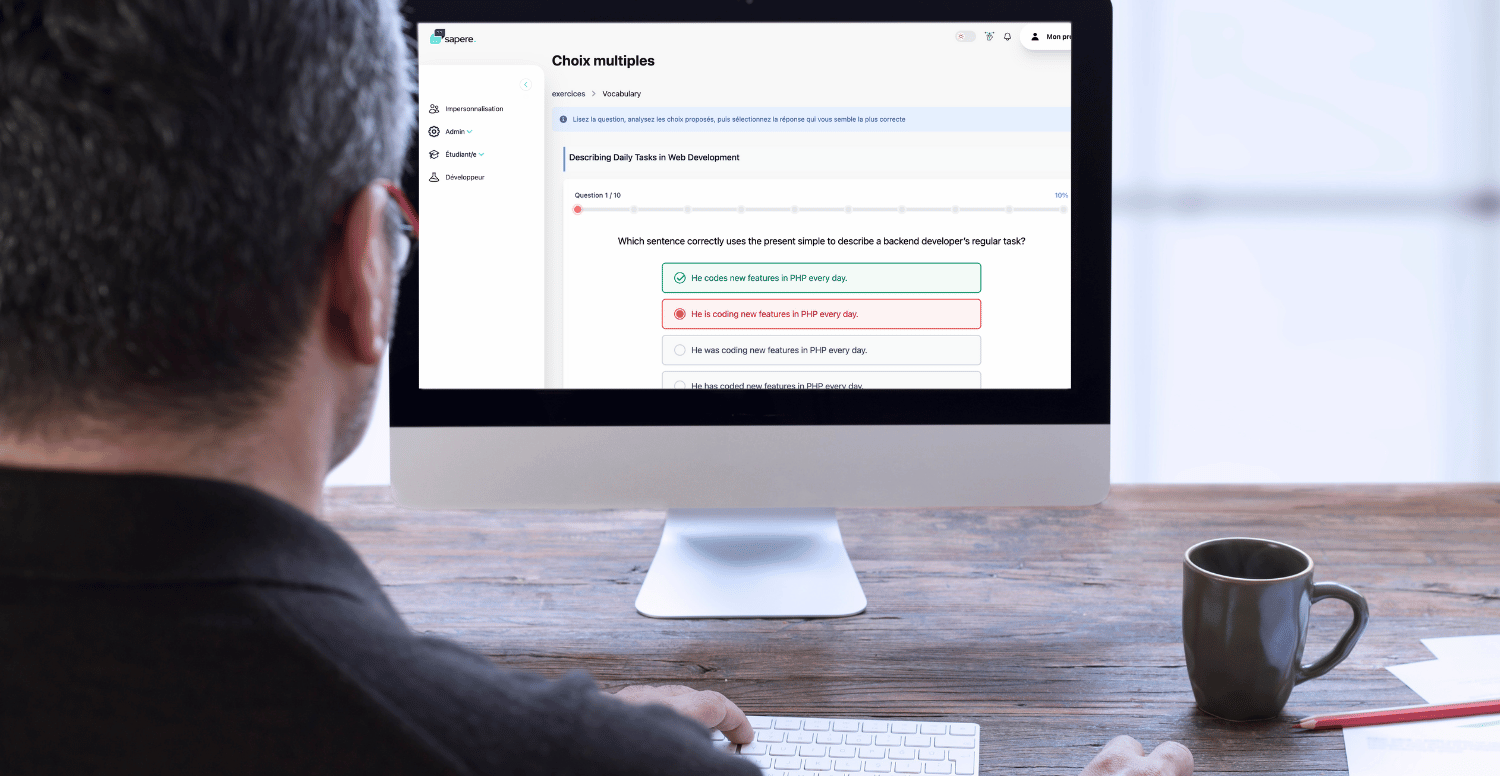
How to Use Artificial Intelligence to Enhance Learning?
Table of Contents
Do you want to make studying easier? At times, lessons can be hard to grasp… and the list of concepts to memorize? Endless. In fact, it is quite common for students to become anxious while preparing for upcoming exams.
Not only is it tedious to read the entirety of a textbook, it is usually not enough to pass one’s exams. Studies show that the best way to memorize course content is by using several study methods, such as reading, writing and listening. Luckily, integrating artificial intelligence into your study routine makes this possible!
This article will address the practicality of AI for students, and how its use for educational purposes can alleviate their anxieties. We will also delve into how AI makes language learning more accessible and fun.
How to Use AI to Learn Better?
As of late, artificial intelligence is being used more frequently in academics; for good reason! To start, it offers tips and tricks for people seeking to learn a new skill. Whether you want to learn the basics of crocheting or how to use advanced tools such as Adobe After Effects, AI can provide detailed explanations that help you pursue your passions. It is also an asset that enriches workplace training for businesses, becoming invaluable to HR departments around the world. Finally, AI is a superb tool for students looking for assistance in their exam preparation. It offers many practical functionalities, including, but not limited to, its ability to create a customized study plan.
How to Use AI to Study?
Artificial intelligence can be used in education to facilitate students’ lives. It can help them study for exams by providing them with various personalized study aids tailored to any subject.
Explaining Concepts
Artificial intelligence can explain complex concepts in a precise, yet comprehensible way. Thanks to its ever-evolving knowledge and unlimited access to online resources, AI can generate accurate responses based on recent findings, so that students may better understand what they are learning. Additionally, it does not limit its knowledge to certain fields: it can give you an equally in-depth analysis of both revolutionary art history and quadric equations. However, it is important to always fact check AI-generated answers.
Generating Study Aids
AI is capable of generating responses to infinite prompts. It also allows students to upload their own study materials, including class notes, teachers’ presentations and textbooks, based on which it generates various study aids. These tools include flashcards, multiple-choice questionnaires or colour-coded guides. These resources can be used in many ways: students can download them and use them on their own, or ask the AI to go even further by creating practice tests and quizzes. These aids make students’ lives easier by shortening their study time and setting them on the right path throughout their studies.
Role-Playing Exercises
Certain studies have shown that kinesthetic learning – the ability to put knowledge into practice – is one of the most effective ways to retain information. Oftentimes, when a student can explain a concept in their own words, whether it be in a casual conversation or by teaching it to someone else, they demonstrate a clear understanding of the study material. Thus, artificial intelligence can help validate a student’s knowledge by initiating a role-playing exercise. The AI asks relevant questions on a particular topic and the student answers them to the best of their ability. At the end of the exercise, it will be able to elaborate on what was more or less understood by the student, and offer suggestions for improvement.
Correction and Feedback
As well as being able to generate study aids and practical exercises, artificial intelligence can also correct a student’s work. When a student completes a questionnaire, the AI corrects it and explains why certain answers are incorrect. For study sessions lasting several days, it also remembers which concepts a student is struggling with, and informs them of such by providing them with additional revision exercises before the exam.

Which Is the Best AI for Studying?
There are hundreds of available AI-powered platforms, but some are more centered on the needs of students than others. The list below highlights the best AI tools for students according to several factors, including their abilities, relevance in education and costs. Note that free artificial intelligence tools often offer paid versions that provide even more services.
Free Artificial Intelligence Tools for Students
Doctrina is an artificial intelligence that creates quizzes according to information and documents provided by the student. In its free version, the tool creates unlimited short quizzes, but with the premium version, it generates longer exams. Students can also prompt the AI to revise and improve their class notes. Its paid version also offers access to the Doctrina chatbot.
Yippity is another artificial intelligence that focuses on quiz creation to help students study for their exams. All they need to do is copy-paste their notes into the application and the AI will integrate them into a practice test with multiple choice questions, true or false questions, and fill-in-the-blanks. Like Doctrina, Yippity also offers a free version and a premium version. The free version allows for one quiz per month, whereas the paid version is unlimited.
ChatGPT is an excellent AI program for creating more natural conversations. Despite the free version’s limitations on the number of prompts it can handle and the length of its responses, this tool can summarize complicated concepts and has access to a large knowledge base. Its paid version has fewer limitations on uploaded documents and has an advanced image generation functionality.
Paid Artificial Intelligence Tools for Students
Mindgrasp has many options for students looking to study for upcoming exams. It has note-taking abilities, and creates quizzes as well as flashcards. It can also summarize long documents, and includes an advanced search engine that helps students find peer-reviewed references for their academic papers. Its paid version also analyzes images and allows students to upload more of their own documents.
Leo is an artificial intelligence based in France that creates study guides and practice tests according to documents provided by the student. They can upload unlimited class notes to the platform, with which it creates colour-coded guides. It can also generate quizzes with multiple choice and true or false questions.
If you're looking for a versatile learning platform that allows you to customize lessons and exercises while offering teaching materials tailored to your needs, give Sapere a try!
AI and Foreign Language Learning
Have you ever wanted to learn a new language? Maybe you have always dreamed of travelling the world and speaking fluently with the locals. Many language learning platforms have integrated AI-powered tools (such as generated practice tests and flashcards) to help you reach these goals! Whether you are a student preparing for a Spanish exam or simply love to learn about different cultures, these programs give you access to high-quality language learning.
How Does AI Enhance Foreign Language Learning?
AI-powered interfaces such as Sapere and Gymglish are very beneficial for learning foreign languages. These AI platforms will help you in your search of knowledge thanks to four invaluable assets:
Personalized Exercises
By analyzing the user’s profile, the artificial intelligence generates exercises and guides that help each student in their exam preparation. Lexical fields, flashcards and reading/listening comprehension exercises are saved to the student’s account and are adjusted in relation to their strengths and weaknesses. AI platforms such as Babbel and Duolingo base themselves on the individual’s language level, and adjust their courses accordingly. As for Sapere, it creates personalized lessons tailored to the user’s academic field and language skills. Artificial intelligence is also programmed to remember a student’s weak points. It can thus offer them additional exercises on these subjects to ensure consistent progress.
Endless Knowledge Base
Language learning in schools often relies on a single textbook used throughout the entire academic year. Teachers draw from it to create homework assignments and exams. This method is not ideal for students or teachers: by limiting education to only one resource, the exercises and learning experience become repetitive. On the other hand, artificial intelligence possesses an infinite amount of knowledge that is updated on a daily basis. Thus, it can generate study aids from different sources across the Internet and offer varied and relevant lessons. AI is at the service of students looking for extra practice, as well as teachers wanting to rework their curriculum.
Efficient Revision
Since artificial intelligence adapts to the student’s level, it can determine which tools will be most effective in supporting their learning. By remembering weak points or vocabulary in need of revision, it can generate exercises that promote steady progress. Certain platforms, such as Sapere, also use recent findings in education research to optimize the user experience. For example, several researchers highlight the importance of studying a little bit every day to retain information. It is for this reason that Sapere’s AI is programmed to send reminders that invite the user to practice daily. With the help of AI’s personalized methods, students can practice only 15 minutes per day and make significant progress.
Gamification
Certain applications like Duolingo use gamification and AI to make language learning more fun. These applications integrate exercises, characters and challenges created by AI to make education entertaining. To begin, the students get experience points for each completed lesson, or thanks to timed exercises aimed at improving their skills. To add a competitive element, users can also try to rank first in the leaderboards and surpass people from around the world. The more points they get throughout the week, the higher their rank will be. Finally, they can add friends on these platforms and work together to achieve common goals. The most common feature of this would be the “Friend Streak”, which encourages two friends to practice everyday to maintain it.

Which Is the Best AI to Learn Languages?
AI-powered platforms centered around language learning go about it in many different ways. The list below describes three main categories in which most of these AI programs fall into: extensive language learning, learning speech and language learning applications. We will also cover the ways in which teachers can use AI while teaching foreign languages.
Extensive Language Learning
Sapere is an AI equipped with a plethora of resources to help users learn different languages, including French, English and Spanish. It generates lexical fields tailored to the student’s academic field so they may learn vocabulary relevant to their daily life. It also offers reading and listening comprehension exercises to ensure a complete understanding of the language. Additionally, it is the first AI that can be used alone by a student or in tandem with a professional teacher. Sapere believes in the importance of educators when it comes to language learning; artificial intelligence can be used in education by facilitating exercise creation and progress tracking. Since AI generates personalized exercises and tailors itself to each student’s level, it is a great option for beginner or advanced learners, as well as for teachers.
Learning Speech
Some artificial intelligence platforms concentrate on teaching languages through oral expression. Unfortunately, they are generally limited to just one language. For example, the free version of Pronounce allows students to learn English for free by analyzing their voice recordings. It then suggests ways to improve their American or British accents, depending on their preference. For paid options, Elsa Speech Analyzer is another AI that helps teach English. It dissects students’ voice recordings to offer more precise recommendations based on several criteria, including grammar, vocabulary and intonation.
Language Learning Applications
To create entertaining lessons, certain applications rely on humour. Duolingo is a good example of this: the characters in the game each have their own personality, and they often interact with players through jokes or silly animations. As for Gymglish, it is a paid application which has also created their own line of eccentric characters. Each exercise tells a story about these characters that fit into a larger story. At the end of each lesson, players watch a clip from a popular film in their studied language, then the AI generates comprehension questions.
In conclusion, artificial intelligence is a practical educational tool that supports students throughout their learning journey. By offering various study materials and creating personalized exercises, AI also enhances language learning, and allows students to make significant progress.


